Unit 4 Our World Topic 1 What's the strongest animal on the farm? Section D课件+内嵌音频
文档属性
| 名称 | Unit 4 Our World Topic 1 What's the strongest animal on the farm? Section D课件+内嵌音频 | 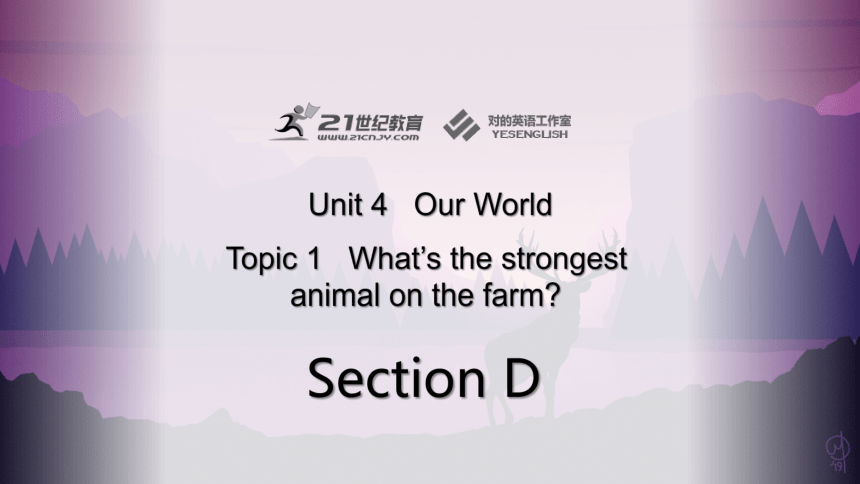 | |
| 格式 | pptx | ||
| 文件大小 | 42.1MB | ||
| 资源类型 | 试卷 | ||
| 版本资源 | 仁爱科普版 | ||
| 科目 | 英语 | ||
| 更新时间 | 2022-11-22 22:09:02 | ||
图片预览

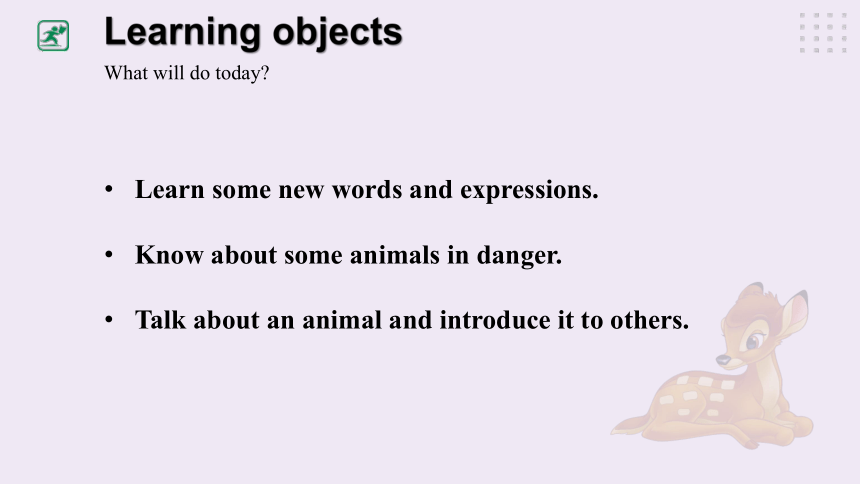
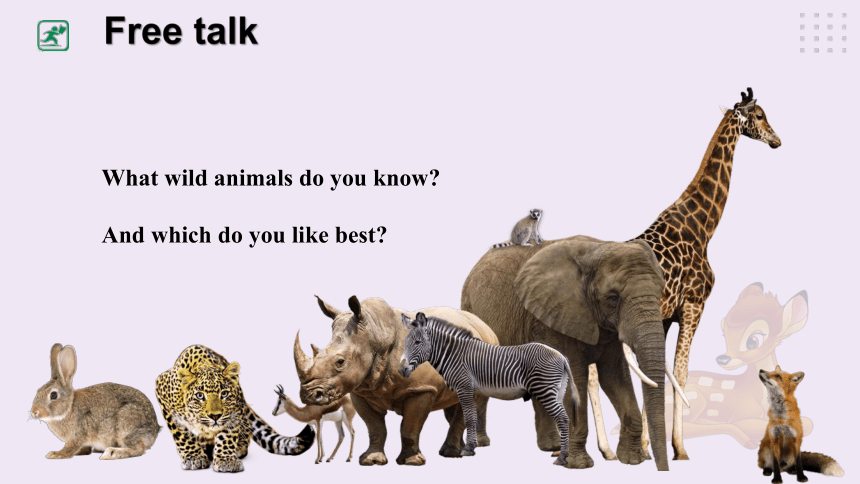
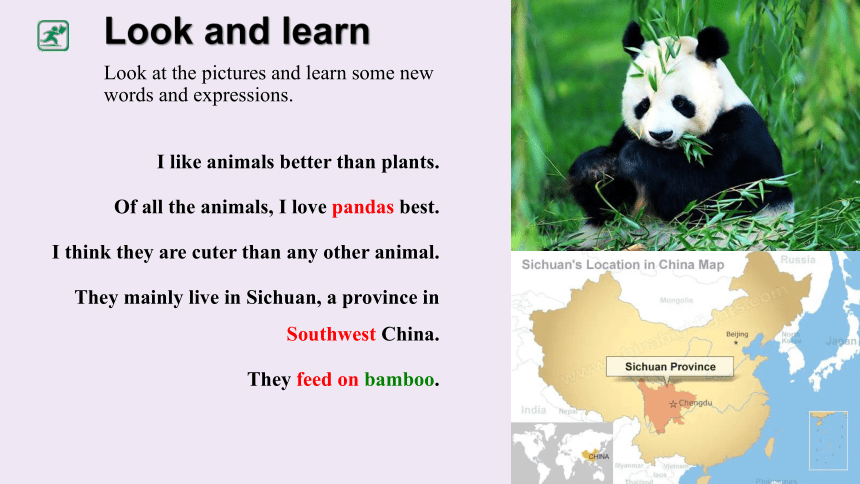
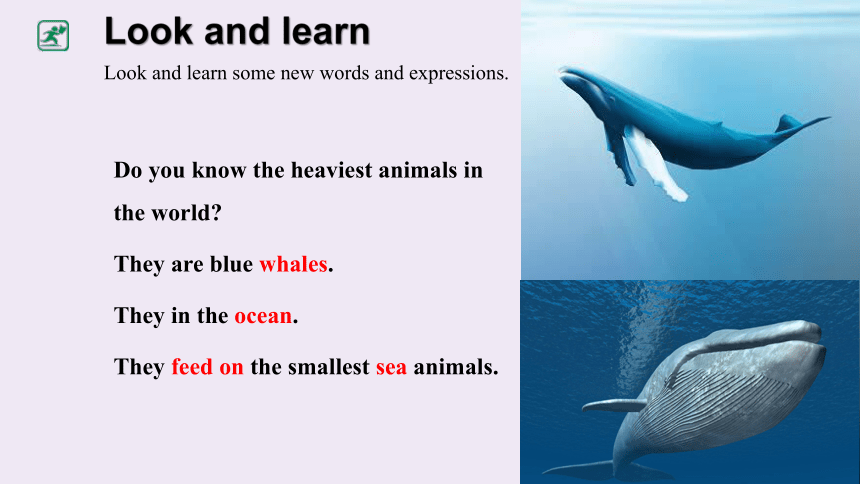
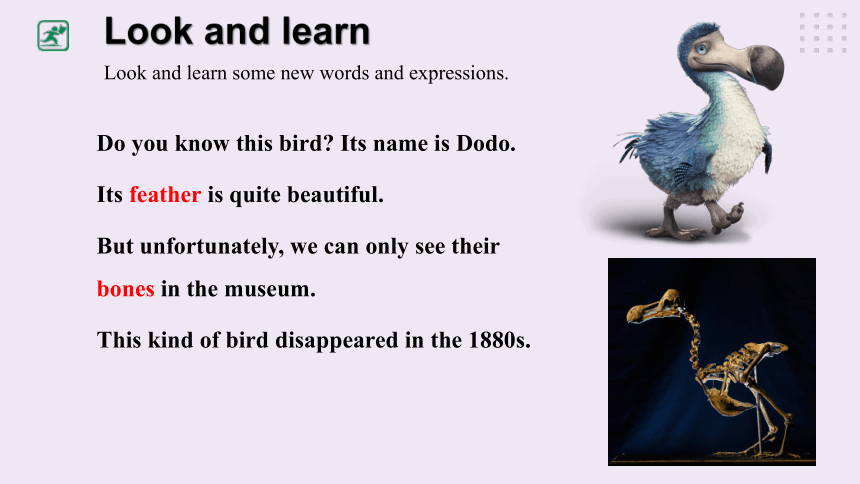
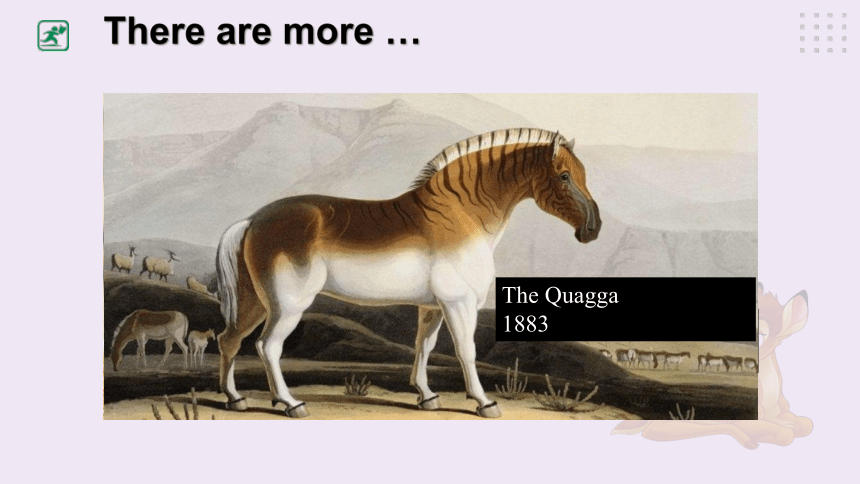
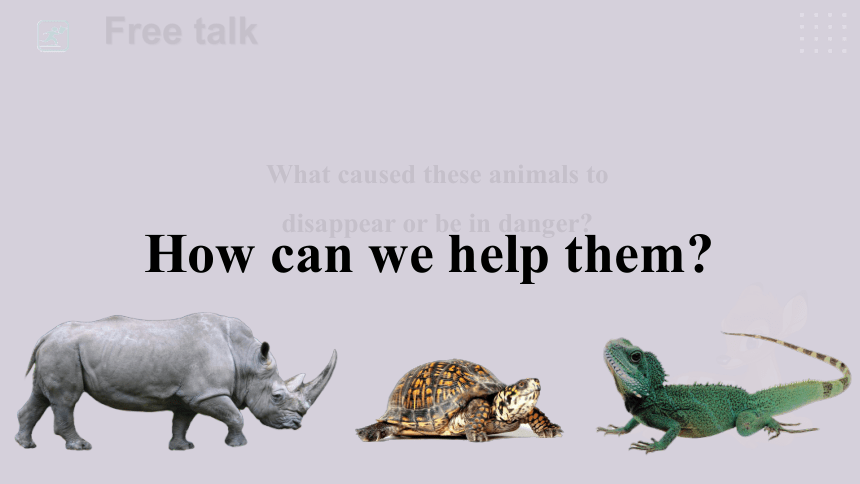
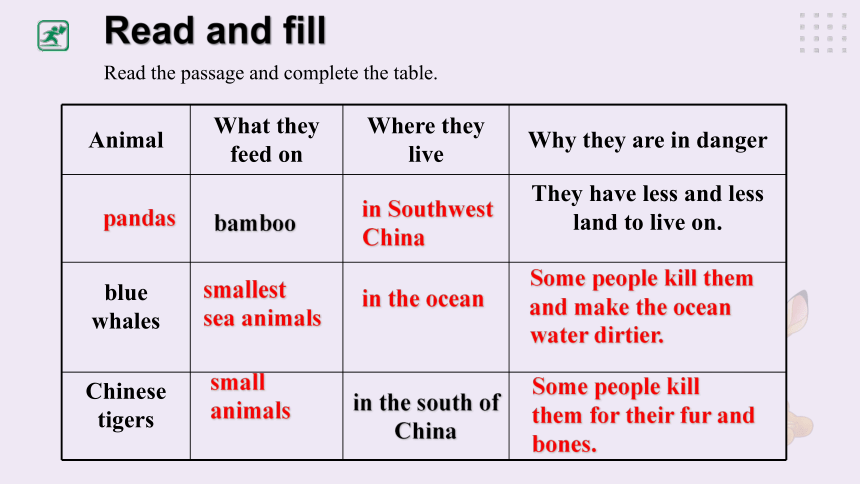
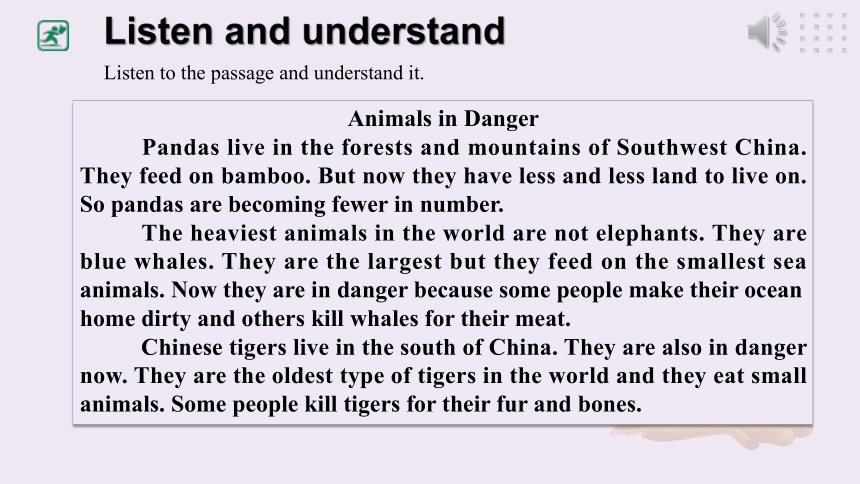
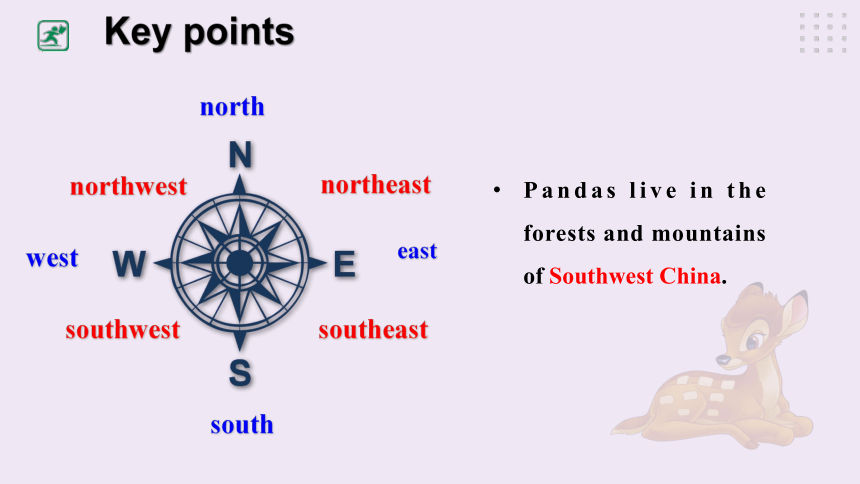
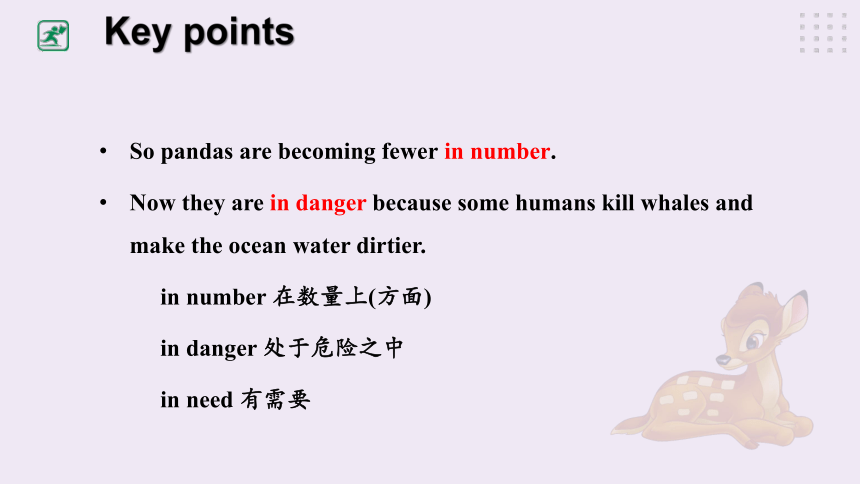
文档简介
(共36张PPT)
Unit 4 Our World
Section D
Topic 1 What’s the strongest animal on the farm
Learning objects
What will do today
Learn some new words and expressions.
Know about some animals in danger.
Talk about an animal and introduce it to others.
Free talk
What wild animals do you know And which do you like best
Look and learn
Look at the pictures and learn some new words and expressions.
I like animals better than plants.
Of all the animals, I love pandas best.
I think they are cuter than any other animal.
They mainly live in Sichuan, a province in Southwest China.
They feed on bamboo.
Look and learn
Look and learn some new words and expressions.
Do you know the heaviest animals in the world
They are blue whales.
They in the ocean.
They feed on the smallest sea animals.
Look and learn
Look and learn some new words and expressions.
Do you know this bird Its name is Dodo.
Its feather is quite beautiful.
But unfortunately, we can only see their bones in the museum.
This kind of bird disappeared in the 1880s.
Splendid poison frog
2020
Spix’s Macaw
Northern White Rhinoceros
2018
Baiji Dolphin
2017
Pyrenean Ibex
2000
Western Black Rhinoceros
2006
The Quagga
1883
There are more …
Free talk
What caused these animals to disappear or be in danger
How can we help them
Read and fill
Read the passage and complete the table.
Animal What they feed on Where they live Why they are in danger
They have less and less land to live on.
blue whales
Chinese tigers in the south of China
bamboo
in Southwest China
smallest
sea animals
in the ocean
Some people kill them and make the ocean water dirtier.
small animals
Some people kill them for their fur and bones.
pandas
Listen and understand
Listen to the passage and understand it.
Animals in Danger
Pandas live in the forests and mountains of Southwest China. They feed on bamboo. But now they have less and less land to live on. So pandas are becoming fewer in number.
The heaviest animals in the world are not elephants. They are blue whales. They are the largest but they feed on the smallest sea animals. Now they are in danger because some people make their ocean home dirty and others kill whales for their meat.
Chinese tigers live in the south of China. They are also in danger now. They are the oldest type of tigers in the world and they eat small animals. Some people kill tigers for their fur and bones.
Key points
Pandas live in the forests and mountains of Southwest China.
north
east
southeast
southwest
northeast
northwest
south
west
Key points
So pandas are becoming fewer in number.
Now they are in danger because some humans kill whales and make the ocean water dirtier.
in number 在数量上(方面)
in danger 处于危险之中
in need 有需要
Key points
They are the oldest type of tigers living in the world.
living in the world 是后置定语 , V-ing 可表进行或伴随
e.g. 你认识正在和我们英语老师谈话的那个男孩吗?
Do you know the boy talking to our English teacher
Retell
Retell the passage with the help of the table.
Animal What they feed on Where they live Why they are in danger
They have less and less land to live on.
blue whales
Chinese tigers in the south of China
bamboo
in Southwest China
smallest
sea animals
in the ocean
Some people kill them and make the ocean water dirtier.
small animals
Some people kill them for their fur and bones.
pandas
Fill
Fill in the blanks according to 1a.
Pandas live in the _______ and __________ of Southwest China. They ______ _______ bamboo. But now they have ______ ____ ______ land to live on. So pandas are becoming _______ in number.
forests
mountains
feed on
less and less
fewer
Fill
Fill in the blanks according to 1a.
The __________ animals in the world are not elephants. They are blue whales. They are the _______ but they feed on the smallest sea animals. Now they are __ _______ because some people make their _______ ______ dirty and others _______ whales for their meat.
heaviest
largest
in danger
ocean home
kill
Fill
Fill in the blanks according to 1a.
Chinese tigers live in the _______ of China. They are also ______ _______ now. they are the ______ _______ ___ tigers in the world and they eat small animals. Some people kill tigers for their ______ and ________.
south
in danger
oldest
type of
fur
bones
Why are they in danger
pandas
blue whales
Chinese tigers
They have less and less land to live on.
Some humans kill them and make the ocean water dirty.
Some people kill them for their fur and bones.
Group work
What should we do to protect the animals in danger
Please discuss and give a report.
Exercises
Choose the best answers.
1. This kind of animal is more dangerous than ____ animal.
A. any B. any other C. other D. the other
2. The eggs in this box are heavier than ____ in that box.
A. those B. that C. these D. the eggs
3. Chinese tigers are ____ now, so we must try our best to protect them.
A. in the danger B. in danger C. out of danger D. in dangerous
4. —Which do you like ____, pandas ____ tigers —Pandas.
A. better; and B. better; or C. best; or D. best; and
5. Lions have _____ land to live on than before. So they are becoming ____ in numbers.
A. less; less B. fewer; fewer C. less; fewer D. fewer; less
6. Who is ____ of the two
A. the tallest B. taller C. the taller D. tallest
Summary
We learn:
some words and expressions: southwest, feed on,
bamboo, land, less and less, whales, sea, ocean,
in danger, fur, bone, features …
something about animals.
We can:
talk about animals in danger and how to protect them.
Homework
Read 1a aloud and fluently and finish the workbook. ( Levels A, B & C)
Write a short passage about the animals you like, similar to 1a. ( Levels A & B )
Make a poster to call for animal protection.
Optional:
Choose another one rare animal you like to enrich your English pamphlet.
https://www.21cnjy.com/help/help_extract.php
Example
golden monkey
(金丝猴)
居住地 中国西南部森林
饮食 树皮(bark)、水果
现状 森林数量减少,失去家园
保护措施 ...
Asian elephant
(亚洲象)
居住地 中国南部
饮食 草,树叶
现状 人类为了象牙(ivory)屠杀它们
保护措施 ...
antelope (藏羚羊)
居住地 中国青藏高原地区(Tibetan plateau)
饮食 草
特点 早上和晚上才出来寻找食物
现状 屠羊制药(kill... for)
保护措施 ...
Brown Eared-pheasant(褐马鸡)
居住地 中国北部
饮食 草,水果和树叶
现状 森林减少,失去家园
保护措施 ...
white wolf (白狼)
居住地 中国西南部森林
饮食 鱼,小兔子等小动物
现状 森林减少,乱扔垃圾,污染严重导致它们失去家园
保护措施 ...
Chinese alligator
(扬子鳄)
居住地 只在中国长江流域(Yangtze River basin)
饮食 小动物
特点 可以整个冬天不吃任何东西
现状 杀鳄取皮(kill...for),居住地污染严重
保护措施 ...
David's deer (麋鹿)
居住地 中国长江流域(Yangtze River basin)
饮食 青草,玉米,胡萝卜
现状 草地用于建房子(use...to)失去家园,食物不足;被杀害来制作药材(kill...to make...)
保护措施 ...
Yangtze River dolphin (白鳍豚)
居住地 中国长江(Yangtze River )
饮食 小鱼,小虾(shrimp)
现状 因人类捕捞(catch)鱼虾而没有足够食物;因长江上很多船只而受伤
保护措施 ...
crested ibis(朱鹮)
居住地 亚洲东部
饮食 小鱼,昆虫(insects)
现状 树木过度砍伐(too many),失去居住地
保护措施 ...
black-necked crane
(黑颈鹤)
居住地 中国西北部高原(highland)
饮食 植物,昆虫(insects)
现状 因有些人认为吃它们的肉对身体有益,而被杀害。
保护措施 ...
Unit 4 Our World
Section D
Topic 1 What’s the strongest animal on the farm
Learning objects
What will do today
Learn some new words and expressions.
Know about some animals in danger.
Talk about an animal and introduce it to others.
Free talk
What wild animals do you know And which do you like best
Look and learn
Look at the pictures and learn some new words and expressions.
I like animals better than plants.
Of all the animals, I love pandas best.
I think they are cuter than any other animal.
They mainly live in Sichuan, a province in Southwest China.
They feed on bamboo.
Look and learn
Look and learn some new words and expressions.
Do you know the heaviest animals in the world
They are blue whales.
They in the ocean.
They feed on the smallest sea animals.
Look and learn
Look and learn some new words and expressions.
Do you know this bird Its name is Dodo.
Its feather is quite beautiful.
But unfortunately, we can only see their bones in the museum.
This kind of bird disappeared in the 1880s.
Splendid poison frog
2020
Spix’s Macaw
Northern White Rhinoceros
2018
Baiji Dolphin
2017
Pyrenean Ibex
2000
Western Black Rhinoceros
2006
The Quagga
1883
There are more …
Free talk
What caused these animals to disappear or be in danger
How can we help them
Read and fill
Read the passage and complete the table.
Animal What they feed on Where they live Why they are in danger
They have less and less land to live on.
blue whales
Chinese tigers in the south of China
bamboo
in Southwest China
smallest
sea animals
in the ocean
Some people kill them and make the ocean water dirtier.
small animals
Some people kill them for their fur and bones.
pandas
Listen and understand
Listen to the passage and understand it.
Animals in Danger
Pandas live in the forests and mountains of Southwest China. They feed on bamboo. But now they have less and less land to live on. So pandas are becoming fewer in number.
The heaviest animals in the world are not elephants. They are blue whales. They are the largest but they feed on the smallest sea animals. Now they are in danger because some people make their ocean home dirty and others kill whales for their meat.
Chinese tigers live in the south of China. They are also in danger now. They are the oldest type of tigers in the world and they eat small animals. Some people kill tigers for their fur and bones.
Key points
Pandas live in the forests and mountains of Southwest China.
north
east
southeast
southwest
northeast
northwest
south
west
Key points
So pandas are becoming fewer in number.
Now they are in danger because some humans kill whales and make the ocean water dirtier.
in number 在数量上(方面)
in danger 处于危险之中
in need 有需要
Key points
They are the oldest type of tigers living in the world.
living in the world 是后置定语 , V-ing 可表进行或伴随
e.g. 你认识正在和我们英语老师谈话的那个男孩吗?
Do you know the boy talking to our English teacher
Retell
Retell the passage with the help of the table.
Animal What they feed on Where they live Why they are in danger
They have less and less land to live on.
blue whales
Chinese tigers in the south of China
bamboo
in Southwest China
smallest
sea animals
in the ocean
Some people kill them and make the ocean water dirtier.
small animals
Some people kill them for their fur and bones.
pandas
Fill
Fill in the blanks according to 1a.
Pandas live in the _______ and __________ of Southwest China. They ______ _______ bamboo. But now they have ______ ____ ______ land to live on. So pandas are becoming _______ in number.
forests
mountains
feed on
less and less
fewer
Fill
Fill in the blanks according to 1a.
The __________ animals in the world are not elephants. They are blue whales. They are the _______ but they feed on the smallest sea animals. Now they are __ _______ because some people make their _______ ______ dirty and others _______ whales for their meat.
heaviest
largest
in danger
ocean home
kill
Fill
Fill in the blanks according to 1a.
Chinese tigers live in the _______ of China. They are also ______ _______ now. they are the ______ _______ ___ tigers in the world and they eat small animals. Some people kill tigers for their ______ and ________.
south
in danger
oldest
type of
fur
bones
Why are they in danger
pandas
blue whales
Chinese tigers
They have less and less land to live on.
Some humans kill them and make the ocean water dirty.
Some people kill them for their fur and bones.
Group work
What should we do to protect the animals in danger
Please discuss and give a report.
Exercises
Choose the best answers.
1. This kind of animal is more dangerous than ____ animal.
A. any B. any other C. other D. the other
2. The eggs in this box are heavier than ____ in that box.
A. those B. that C. these D. the eggs
3. Chinese tigers are ____ now, so we must try our best to protect them.
A. in the danger B. in danger C. out of danger D. in dangerous
4. —Which do you like ____, pandas ____ tigers —Pandas.
A. better; and B. better; or C. best; or D. best; and
5. Lions have _____ land to live on than before. So they are becoming ____ in numbers.
A. less; less B. fewer; fewer C. less; fewer D. fewer; less
6. Who is ____ of the two
A. the tallest B. taller C. the taller D. tallest
Summary
We learn:
some words and expressions: southwest, feed on,
bamboo, land, less and less, whales, sea, ocean,
in danger, fur, bone, features …
something about animals.
We can:
talk about animals in danger and how to protect them.
Homework
Read 1a aloud and fluently and finish the workbook. ( Levels A, B & C)
Write a short passage about the animals you like, similar to 1a. ( Levels A & B )
Make a poster to call for animal protection.
Optional:
Choose another one rare animal you like to enrich your English pamphlet.
https://www.21cnjy.com/help/help_extract.php
Example
golden monkey
(金丝猴)
居住地 中国西南部森林
饮食 树皮(bark)、水果
现状 森林数量减少,失去家园
保护措施 ...
Asian elephant
(亚洲象)
居住地 中国南部
饮食 草,树叶
现状 人类为了象牙(ivory)屠杀它们
保护措施 ...
antelope (藏羚羊)
居住地 中国青藏高原地区(Tibetan plateau)
饮食 草
特点 早上和晚上才出来寻找食物
现状 屠羊制药(kill... for)
保护措施 ...
Brown Eared-pheasant(褐马鸡)
居住地 中国北部
饮食 草,水果和树叶
现状 森林减少,失去家园
保护措施 ...
white wolf (白狼)
居住地 中国西南部森林
饮食 鱼,小兔子等小动物
现状 森林减少,乱扔垃圾,污染严重导致它们失去家园
保护措施 ...
Chinese alligator
(扬子鳄)
居住地 只在中国长江流域(Yangtze River basin)
饮食 小动物
特点 可以整个冬天不吃任何东西
现状 杀鳄取皮(kill...for),居住地污染严重
保护措施 ...
David's deer (麋鹿)
居住地 中国长江流域(Yangtze River basin)
饮食 青草,玉米,胡萝卜
现状 草地用于建房子(use...to)失去家园,食物不足;被杀害来制作药材(kill...to make...)
保护措施 ...
Yangtze River dolphin (白鳍豚)
居住地 中国长江(Yangtze River )
饮食 小鱼,小虾(shrimp)
现状 因人类捕捞(catch)鱼虾而没有足够食物;因长江上很多船只而受伤
保护措施 ...
crested ibis(朱鹮)
居住地 亚洲东部
饮食 小鱼,昆虫(insects)
现状 树木过度砍伐(too many),失去居住地
保护措施 ...
black-necked crane
(黑颈鹤)
居住地 中国西北部高原(highland)
饮食 植物,昆虫(insects)
现状 因有些人认为吃它们的肉对身体有益,而被杀害。
保护措施 ...
同课章节目录
- Unit 1 Playing Sports
- Topic 1 I'm going to play basketball.
- Topic 2 I'll kick you the ball again.
- Topic 3 The school sports meet is coming.
- Unit 2 Keeping Healthy
- Topic 1 You should brush your teeth twice a day.
- Topic 2 I must ask him to give up smoking.
- Topic 3 Must we exercise to prevent the flu?
- Unit 3 Our Hobbies
- Topic 1 What's your hobby?
- Topic 2 What sweet music!
- Topic 3 What were you doing at this time yesterday
- Unit 4 Our World
- Topic 1 What's the strongest animal on the farm?
- Topic 2 How can we protect ourselves from the eart
- Topic 3 The Internet makes the world smaller.
